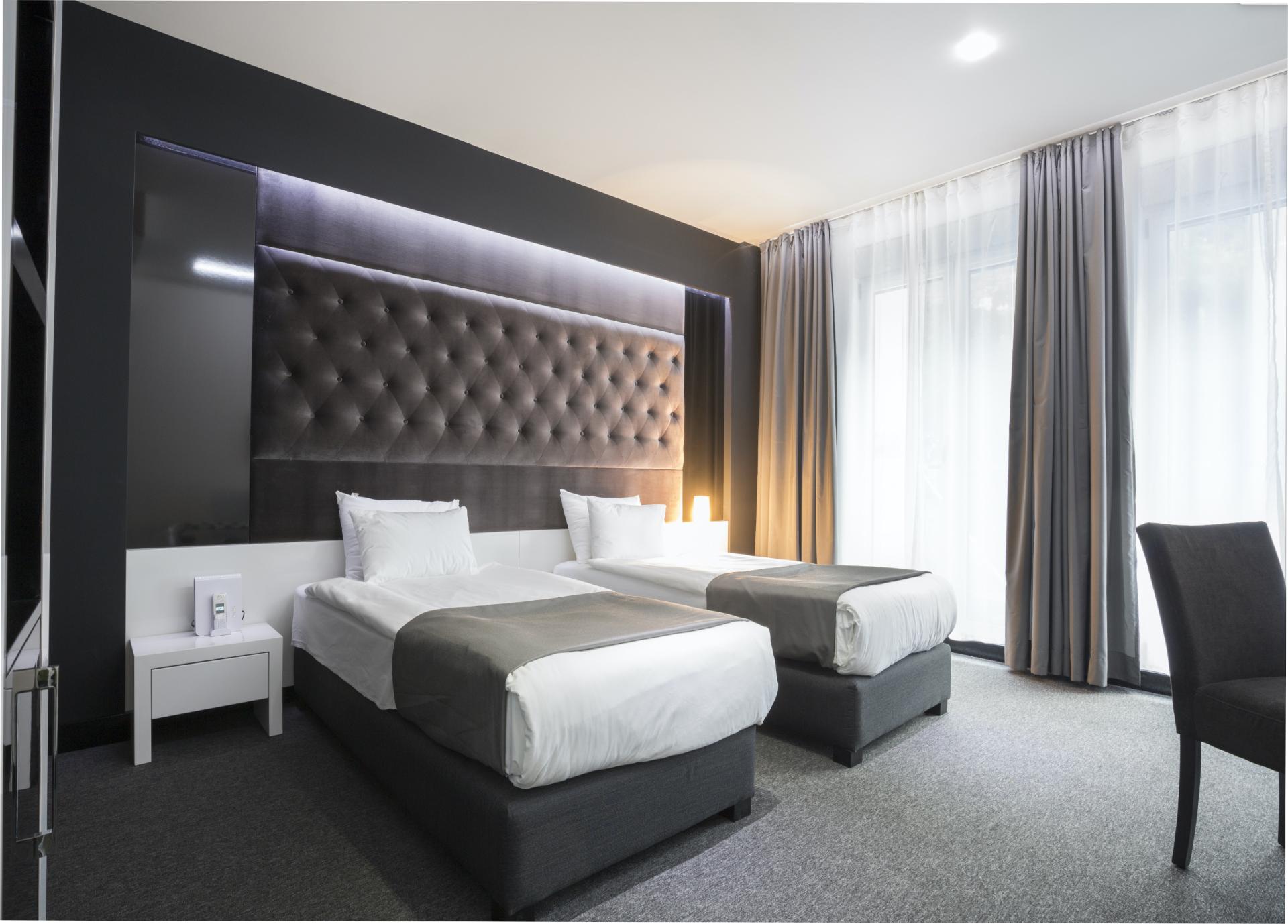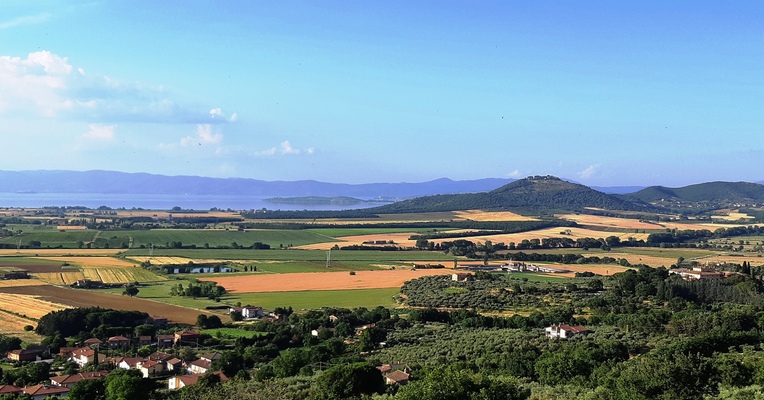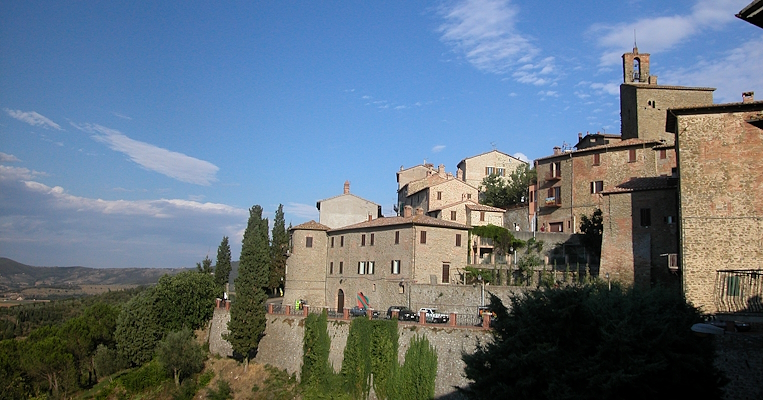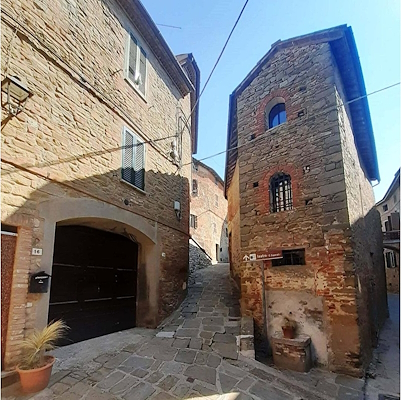Watchword: harmony
Panicale perfectly preserves the structure of a mediaeval fortified village; situated on the top of one of the hills overlooking Lake Trasimeno, Mount Petrarvella, it superbly dominates the view of the blue horizon of the lake on one side and the wide Nestore valley on the other.
The view from the Umbrian village seems to reflect the criteria of order and balance that inspired Perugino's beautiful paintings. The clear waters of the lake in the distance, the gentleness of the reliefs, the olive and oak trees, the walls, towers and churches dominated by the warm colour of brick stand together in a perfect relationship, in which the sky, earth and water seem to dialogue in a whole of rare harmony. Looking out from Panicale, from one of its many glimpses into the streets and houses of the village, gives us a better understanding of Umbria, its nature, its seasons.
A name, a history
The origins of the name Panicale are still uncertain. For some it would be linked to Pan, the goat god of Greek mythology linked to the woods, sheep farming and nature. For others, more prosaically, it would emphasise the area's cereal-growing tradition, defined at one time as ‘the granary of Perugia’ for the large supply of cereals that it was able to guarantee to the city: panicum is a cereal similar to millet, the plant of which is featured on the municipal coat of arms.
The origin of the town can be traced back to between the 7th and 6th centuries BC, by the powerful Etruscan lucumonia of Chiusi. Its strategic position characterised its history over the centuries. The ancient settlement provided a providential escape route for Roman legionaries pursued by Hannibal's Carthaginian soldiers after the defeat at Lake Trasimeno in 217 BC. The existence of Panicale is also documented on the occasion of the bellum perusinum between Lucius Antonius and Octavian Augustus, in 41 BC, when it provided shelter to those who escaped from the city following the latter's siege.
Panicale, “renowned land”
Because of its position, numerous potentates contended for dominion of the castle over the centuries.
In the 10th century, it was granted by Emperor Berengar to Duke Uguccione II of Bourbon. In 1037, however, the proud and indomitable inhabitants of Panicale proclaimed themselves a free commune. In 1201 this was subjugated to Perugia, and suffered looting and ruin like most of the fortified centres in the Trasimeno area, so much so that the Perugian commune rebuilt its walls in 1246, and in 1312 strengthened its fortifications. The walls made it a safe city: this is why it was chosen as a stopping place by important figures, including Pope Innocent III in 1216 and Emperor Henry VII in 1312. In the 15th century, although subjected several times to powerful Perugian families, including the Baglioni, Panicale experienced great economic and urban development and an artistic flourishing that is still reflected today in the appearance it shows visitors. In June 1495 it hosted Pope Alexander VI; in 1516 Julius II and in 1543 Paul III, who was responsible for the construction of the imposing Perugian fortress that took his name.
In 1540, the village became part of the Papal State, and remained so until the Unification of Italy, apart from the brief period of Napoleonic occupation. It was also besieged in 1646, during the war between the Papal State and the Duchy of Parma, and suffered further looting and damage.
This fortress city with an incomparable view was the birthplace of more than one personality.
One of the most terrible mercenary captains of the time, Giacomo Paneri, known as Boldrino da Panicale (‘the Flagellator of the March, the scourge of the Italian Militia’), was born in 1331, in a house in Piazza San Michele Arcangelo (as commemorated by a plaque on its façade). It is said that the towns he passed through offered him large amounts of money so that he would not stay within their walls. The Umbrian village also contends with the other Panicale, in Tuscany, for the birth of the famous Renaissance painter Tommaso Fini, known as Masolino da Panicale, around 1380. Recent research favours an Umbrian origin for Masolino da Panicale, a pupil of Ghiberti and very delicate painter of Madonnas. Cesare Caporali was born in Panicale in 1530, a playful poet, employed at the Della Corgna court in the splendid residence of Castiglione del Lago, whose magnificence he sang of in his ‘Orti di Mecenate’.
Discovering the village
The ancient castle retains its towers, keeps and two gates, the Porta Perugina, to the east, rebuilt in 1898, and the Porta Fiorentina, to the west, which bears traces of the drawbridge. The urban structure develops around the hill following the unevenness of the terrain, and is therefore perfectly elliptical. On an axis with the two ancient gates are the three main squares, placed at different levels: Piazza Umberto I, at the bottom, associated with economic power, Piazza San Michele Arcangelo, the seat of religious power, and finally, higher up, Piazza Masolino, destined for political power.
Piazza Umberto I was built so as to allow the waters of the octagonal travertine cistern dating back to 1473 to drain away, at the centre of which it was transformed into a fountain only in 1903. It still bears, carved on one of its sides, the coat of arms of Panicale: a tower framed by two ears of corn. Overlooking the square is the ancient municipal seat of the 13th-century Palazzo Pretorio, in terracotta and sandstone, richly decorated with stone coats of arms.
Nearby is the "Cesare Caporali" Theatre, a very important cultural centre for the small village. Founded as the ‘Teatro del Sole’ in 1786, it was entirely rebuilt in 1858 by architect Giovanni Caproni; on that occasion, the curtain was made by Mariano Piervittori da Tolentino, author of the most famous stage curtains of the major Umbrian theatres. Piervittori's painting, in keeping with the taste for medieval and renaissance epics in vogue at the time, depicts the mercenary captain Boldrino da Panicale being honoured by the city of Perugia.
Going up, one comes to the beautiful square overlooked by the Collegiate Church of San Michele Arcangelo, one of the oldest sacred buildings in the area. Its foundation dates back to the 10th century, as can be seen from the entrance arches and the façade, partly compromised by later interventions, including the creation of a corridor linking the church to the adjoining palace. It was, however, completely rebuilt in 1618 by decision of Pope Paul V, who turned it into a Collegiate Church, and again renovated between 1680 and 1695. It houses a beautiful 15th century Annunciation, attributed to the painter Masolino. Found in 1684, it became an object of great devotion, so much so that the image was detached and a small chapel was dedicated to it. The church still houses a panel painting of the Nativity dated 1519, probably the work of Giovanni Battista Caporali (son of the better-known Bartolomeo), a beautiful 15th-century wooden crucifix with jointed arms, still used today in the rites of Holy Week, and six medallions with Stories of Mary from the late 17th century.
In the upper part of the town is Piazza Masolino, dominated by the massive 14th-century Palazzo del Podestà, built in Lombard Gothic style with the expertise of the schools of Comacini masters. The inhabitants of Panicale call it the ‘Campanone’, because its bells still toll the hours.
In Piazza Regina Margherita, at the top of a flight of steps, stands the church of Sant'Agostino. There you can admire a beautiful pietra serena altar, the work of Giambattista di Cristoforo from 1513, remains of 14th-century frescoes of the Giotto school, and others from the 16th century, in which the hand of Pietro Vannucci and his school has been glimpsed. Closed to worship, since 2001 it has housed the "Anita Belleschi Grifoni" Tulle Museum, dedicated to the Ars panicalensis, artistic lace-making practised and disseminated in the area by the nuns of the Collegio delle Vergini; the college was closed in 1872, but in the 1930s Anita Belleschi Grifoni resumed its use, perfecting the craftmanship and simplifying the stitches. This is needlepoint embroidery done directly on cotton or silk tulle.
Not far away, outside the Porta Perugina, is one of the most interesting and visited places in the village: the Church of San Sebastiano, a 15th-century chapel with simple forms, but which houses inside one of the masterpieces by Pietro di Cristoforo Vannucci, known as Perugino: the enchanting Martyrdom of St. Sebastian, painted between the spring and autumn of 1505. The fresco occupies the entire back wall of the building, and depicts the martyrdom of the saint within a landscape of extraordinary lightness and gentleness. The church also contains a fresco of the Madonna Enthroned. Coming from the nearby Sant'Agostino, it was attributed to Perugino, and more recently, to his great pupil Raphael.
On the opposite side of the town, at the end of a beautiful tree-lined avenue, is the Church of the Madonna della Sbarra, so called because it once stood near the bar of a customs post. Begun in the 15th century but not completed until 1625, it was dedicated to the Madonna delle Nevi in memory of the exceptional snowfall that occurred on 5 August 552. The building speaks Tuscan in style and finish; it preserves the miraculous image of the Madonna and Child on which the church was built (1415), and a Stations of the Cross from 1791. The upper floors of the building house a small Museum of Sacred Vestments.
Finally, if you want to learn more about the history of the town, in Via Pietro Vannucci, inside the Town Hall, a visit to the Mariottini Art Gallery is recommended, which houses 31 canvases depicting celebratory portraits of men of the town.
Around Panicale
The beautiful hilly landscape around the town, made up of cedar and oak forests, is dotted with numerous castles: Montalera, of ancient origin but renovated in the 16th century by Braccio Baglioni, who turned it into a noble residence; Montali, now in ruins, from which there is an incomparable view; Greppolischieto, immersed in a forest of oaks, elms and chestnuts. They have been purchased by private individuals.
Cibottola, which almost entirely retains the character of a fortified settlement, is worth a stop. It is located along the road travelled by St Francis on his way to Tuscany, and the charming remains of the Franciscan monastery of St Bartholomew can be admired here.
Along the road between Panicale and Tavernelle is the Sanctuary of the Madonna delle Grondici, which offers a breathtaking view of the surrounding valleys. It was built in memory of a miracle that occurred in the 15th century, but was entirely restored in modern times and is incredibly rich in ex-votos.
Not far away, about 8 km from Panicale, a beautiful Renaissance building with a central plan houses the Sanctuary of the Madonna di Mongiovino. Built starting in 1513 by Rocco di Tommaso da Vicenza, it commemorates the miraculous apparition of the Virgin to a little girl near a shrine dedicated to St Martin. Beyond the beautiful pietra serena portals, one can admire inside the church frescoes by Pomarancio, Arrigo Fiammingo and Giovan Battista Lombardelli (16th century), and the Baroque decoration of the dome by Mattia Batini from Città di Castello; above the entrances, two oil paintings depict 24 ex-votos relating to miracles that occurred between 1825 and 1830.































